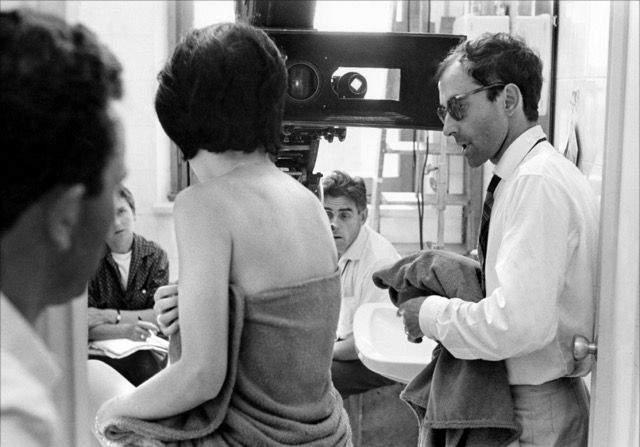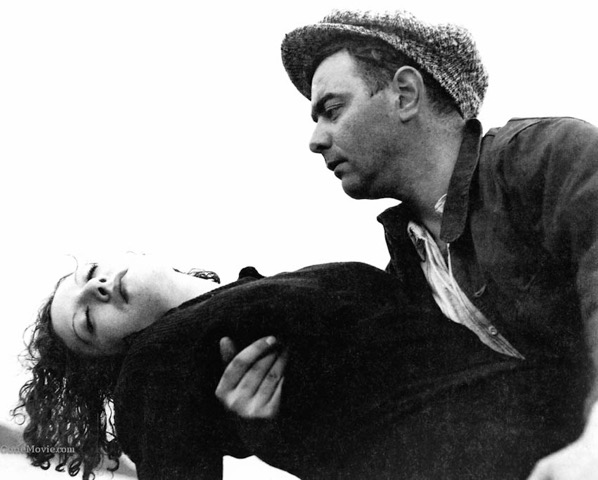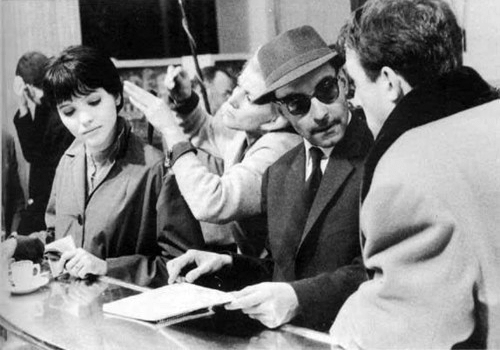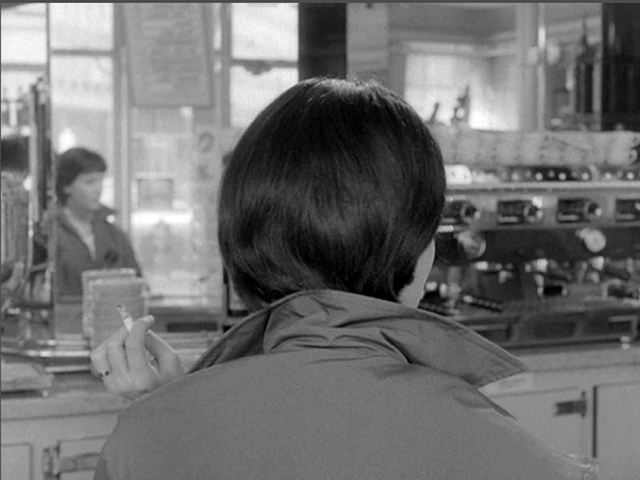 |
Jean-Luc Godard directs Anna Karina in Vivre Sa Vie (1962) |
The following 1962 interview between Jean-Luc Godard and journalist Tom Milne was recorded when Vivre sa vie (1962) was shown at the London Film Festival prior to its run at the Academy Cinema.
It is often said that the Nouvelle Vague directors claim to be totally uncommitted. Leaving aside the question of political commitment, would you say that you are artistically committed?
When the Nouvelle Vague started, several films included scenes of wild parties, and everybody pounced on them to label the Nouvelle Vague as interested only in wild parties. But it was really mere chance – just as at one time Jean Gabin was a deserter or a member of the Foreign Legion in all his films, and nobody went about drawing conclusions. In any case the word “commitment” is mostly used wrongly, generally by people on the left. One is not committed just because one makes films about the working class or about social questions; one is committed in so far as one is responsible for what one does. In the early days I felt responsible because I was not fully aware, but now… yes, I am committed in that I grow more and more conscious of what I am doing and my responsibility for it.
It seems to me that the keynote of your early films was simply the joy of making films.
Yes, I think that’s so. We were all critics before beginning to make films, and I loved all kinds of cinema – the Russians, the Americans, the neorealists. It was the cinema which made us – or me, at least – want to make films. I knew nothing of life except through the cinema, and my first efforts were “films de cinéphile,” the work of a film enthusiast. I mean that I didn’t see things in relation to the world, to life or history, but in relation to the cinema. Now I am growing away from all that.
Would it be true, then, to say that Vivre sa vie is a new departure for you?
No, I feel rather that it’s an arrival. I like to say that there are two kinds of cinema, there is Flaherty and there is Eisenstein. That is to say, there is documentary realism and there is theatre, but ultimately, at the highest level, they are one and the same. What I mean is that through documentary realism one arrives at the structure of theatre, and through theatrical imagination and fiction one arrives at the reality of life. To confirm this, take a look at the work of the great directors, how they pass by turns from realism to theatre and back again.
 |
Jean Renoir's Toni (1935) |
Like Renoir, you mean?
Renoir is a model example because he not only does it supremely well, he is aware of it. From the neorealism of Toni he arrived at naturalism, moved off into the theatre again, and now in television is seeking the utmost simplicity. I started, as I thought, in realism, but I now realise that A bout de souffle was made quite unconsciously on my part. I thought I knew what it was about, but now, a year or two later, I’m conscious that I had no idea. I thought it was a realistic film, but now it seems like Alice in Wonderland, a completely unreal, surrealistic world. I feel, though, that with Vivre sa vie I am beginning, gradually, to make more realistic films, more concrete films if you like.
Is this the reason for the Brechtian influence in the film?
Yes, I discovered the theatre. I wanted to do Pirandello’s Six Characters in Search of an Author but the rights were too expensive. I should have liked to do it to show the common ground between realism and theatricality. Each has its separate frontier but there are certain points at which they merge.
Truffaut once said that if the public did not like a film of his then he considered that it was a failure. Do you feel that Une Femme est une femme is a failure because it did not attract the public?
No, I don’t think so, because a certain number of people liked it. You must remember that Truffaut is half producer, half director – in the morning he is a businessman, in the afternoon an artist – and so this question of the public is more pressing for him. I think one must aim to attract the widest possible audience, but obviously this will be smaller for Vivre sa vie or Paris nous appartient than for Ben-Hur. One must be sincere, believe that one is working for the public, and aim at them. In my early days I never asked myself whether the audience would understand what I was doing, but now I do. If Hitchcock, for example, thinks that people will not understand something, he will not do it. At the same time I feel that one must sometimes just go ahead – light may always dawn in a few years time. But of course one must be sure one knows what one is about, because if one just goes ahead and does something, saying, “They won’t understand but it won’t matter,” one may be disastrously wrong and find that it does matter.
 |
Jean-Luc Godard and Anna Karina on the set of Vivre Sa Vie (1962) |
I brought this up because the opening scene of Vivre sa vie seems to me to be a bold directorial conception which stands a strong chance of being misunderstood.
Perhaps, but I think that as soon as people see something a little unusual on the screen they try too hard to understand. They understand perfectly well, really, but they want to understand even more. If you show them someone drinking tea or saying goodbye, they immediately say yes, but why is he drinking tea? People didn’t like Une Femme est une femme because they didn’t know what it meant. But it didn’t mean anything. If you see a bouquet of flowers on a table, does it mean something? It doesn’t prove anything about anything. I simply hoped that the film would give pleasure. I meant it to be contradictory, juxtaposing things which didn’t necessarily go together, a film which was gay and sad at the same time. One can’t do that, of course, one must be either one or the other, but I wanted to be both at once.
Do you consider the editing of your films important?
For me there are three equally important moments in making a film – before, during, and after the actual filming. With somebody like Hitchcock everything is calculated down to the last second, and so the editing is less important. A bout de souffle owes a great deal to the montage. It is a film in three movements, the first half-hour fast, the second moderato, and the third allegro vivace again: I thought of the film this way before actually beginning shooting, but in a rather vague way. Vivre sa vie, on the other hand, owes very little to the editing, as it is really a collection of shots placed side by side, each one of which should be self-sufficient. The curious thing is that I think the film looks carefully constructed, whereas I made it extremely rapidly, almost as if I were writing an article without going back to make any corrections. I wanted to make the film like this, without shooting a scene and then trying it in another way, although one or two shots were reshot. But I somehow felt that I had to find out right away what I wanted to do and do it, and that if it was going to be good it would be good first time. Vivre sa vie is a realistic film, and at the same time extremely unrealistic. It is very schematic: a few bold lines, a few fundamental principles. I was thinking, in a way, as a painter, of confronting my characters head-on as in the paintings of Matisse or Braque, so the camera is always upright.
Long shots and elaborate camera angles are always rare in your films. Is this perhaps because your point of departure is always a character, and you like to keep close to him?
Perhaps – as a general rule I like to use medium shots, possibly because long shots are more difficult. Certainly close shots are more moving, if they are good. One might say Rossellini’s failure is that the principle feature and beauty of his films is that they are shot from remote distances. He probably shoots them like this on the assumption that his underlying conception is the most important thing, but people seen from a distance are rarely very moving. I have always traced a character’s history from an emotional point of view, trying to make the audience understand and become involved with him. Les Carabiniers will be my first film to deal with a group of people rather than an individual.
 |
Anna Karina in Vivre Sa Vie (1962) |
What exactly is the role of improvisation in your work?
Strictly speaking it’s wrong to say that I use improvisation, except in so far as I always work at the last minute. I always use a written text, though it may often be written only two or three minutes before shooting. My actors never improvised, in the Actors Studio sense, in A bout de souffle, though they did a little in Une Femme est une femme. Usually the lines are written at the very last minute, which means that the actors have no time to prepare. I prefer this, because I am not a director of actors like Renoir or Cukor, who can rehearse an actor over and over until he manages to coax out a good performance. I like to sneak up on an actor from behind, leaving him to fend for himself, following his groping movements in the part, trying to seize on the sudden, unexpected good moment which crops up spontaneously; and so gradually I build up an idea of what I am trying to do myself. With Vivre sa vie, for example, I started with the idea that it was begin where A bout de souffle left off. Patricia, in A bout de souffle, is a girl whom we see, as it were, from behind, and who faces us fully for one brief instant. So I knew that Vivre sa vie was to start with a girl seen from behind – I did not know why. It was the only idea I had, and I couldn’t tell Anna much, so she cast about without knowing what I wanted, while I tried to work out my conception. We certainly improvised in the sense that I changed my mind all the time, deciding to do this, then that.
Why are you interested in doing Pour Lucrèce? I should have thought that Giraudoux’s style was a little too mandarin for you.
I have always wanted to do a classical play – classical in the French sense, that is, as I consider Giraudoux to be. The cinema is always talked about from the point of view of the images, and at the moment I find myself more interested in the sound. I want to carry this interest to its logical conclusion and simply direct a voice on the screen, show someone more or less motionless on the screen speaking a fine text. At the beginning of the film, perhaps, there will be the camera and the actors taking up their positions with their scripts, beside a chair or in a garden, and then beginning to read. You will see them reading their lines, until gradually we will have moved inside the play and the scripts will no longer be seen. The beauty of the cinema is that, whereas in the theatre if someone dies, at the end he must get up and one does not really believe it, in the cinema one can indicate that it is only an actor, but at the same time one can believe in his death because the cinema is real, it films reality. So, starting from theatre one can move into reality. And another thing that interests me about the play is that it is about purity. It is about a woman who believes that she is Lucretia, and the end of the film will consist of Giraudoux’s words: “Purity is not of this world, but once in ten years its light shines briefly.” For me it will be as if I had filmed the brief glow of this light: The whole world is impure, but there will be a film which represents purity.
Have you any idea what you want to do next, in the sense of how you would like to develop as a director?
In a way I have had enough. I have made four films in three years and I am tired. I would like to pause for a while. What worries me is that I find I am no longer thinking in terms of cinema, but I don’t know whether this is a good or a bad thing. When I was making A bout de souffle or my earlier shorts, a shot of Seberg would be made from a purely “cinematic” point of view, making sure that her head was just at the right cinematic angle, and so on. Now I just do things without worrying how they will appear cinematically. I really don’t know whether this is a good thing or not. |
read more French New Wave interviews >>
|